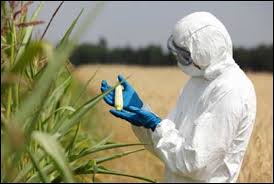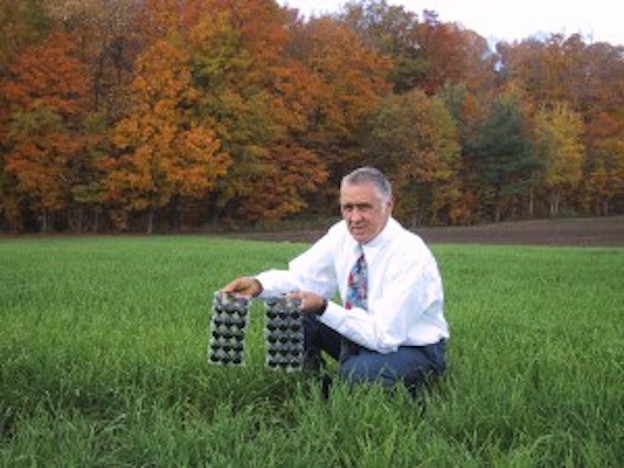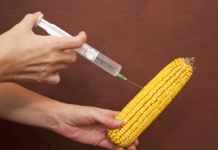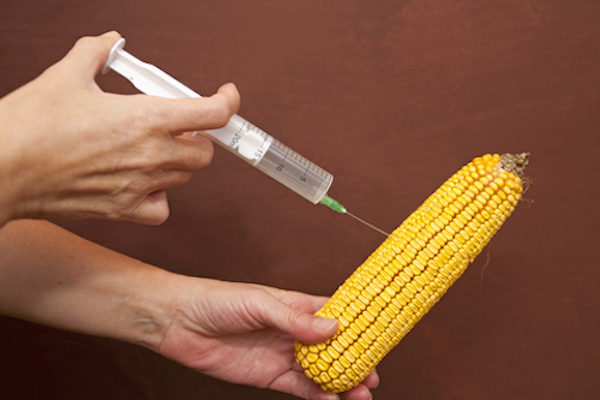Monsanto, the American company that invented Roundup (glyphosate), was recently purchased by Bayer in Germany. Roundup is a broad-spectrum agricultural chemical that was discovered in 1970 and seemed to be environmentally friendly at the time. There was just one small problem — glyphosate is so toxic that it killed every plant it touched. So for the next 20 years or so Monsanto sold Roundup only as a pre-emergent herbicide for preventing weeds before any crops.
Monsanto spent decades and millions of dollars to find a way to make Roundup more profitable. Finally, two decades later, they invented “biotechnology.” With biotechnology they could design or “engineer” crops (GMOs) just to survive Roundup. All they had to do was engineer the genes in their new Roundup Ready plants! Crops that are “Roundup Ready” today include corn, canola, alfalfa, cotton, and sorghum (with wheat is coming soon).
Not So Environmentally Friendly After All.
 Roundup Ready crops are genetically modified with a gene from a bacteria called agrobacterium that makes them Roundup-tolerant. Once inserted into a plant’s genome, this gene gives crops resistance to glyphosate. Unfortunately, however, it doesn’t actually help people survive the many diseases now associated with glyphosate!
Roundup Ready crops are genetically modified with a gene from a bacteria called agrobacterium that makes them Roundup-tolerant. Once inserted into a plant’s genome, this gene gives crops resistance to glyphosate. Unfortunately, however, it doesn’t actually help people survive the many diseases now associated with glyphosate!
The Sad Truth — We Never Needed Glyphosate Anyway!
You see, we already had several non-toxic agricultural technologies that could eliminate most pests and diseases for crops. Things like from companion planting, cross-breeding, biodynamic farming, French-intensive farming and more help farmers grow all the food we need without poisoning the planet. In fact, farmers can enjoy higher yields than is possible with chemical-based agriculture. Today, many countries around the world actually ban glyphosate. So how do they eat? Are they starving?
These countries have learned how to use more sustainable types of farming that keep our planet’s ecosystems in balance. They discovered natural methods that respect wildlife, nurture the soil, reduce greenhouse gases and protect water and other natural resources. We can grow all the healthy food our planet needs with non-GMO and organic agriculture.
Of course, agribusiness “scientists” say this is all silly, citing numerous studies to prove it. What they don’t say is that GMO safety studies are mostly paid for, either directly or indirectly, by companies like Bayer/Monsanto. But one thing they won’t be able to explain is why nearly everyone in America today has measurable levels of Roundup/glyphosate in their blood! They promised us that Roundup is designed to break down in the environment. Apparently they were either wrong or lying.
Truly independent studies are sadly much harder to find than the those that the industry likes to rely on. But honest scientists don’t have the financial support that chemical companies regularly “donate” to universities. You can look them up yourself with a Google search, but I’ll cite a few at the end of this article to get you started. Remember, when you look at a glyphosate study question where it was done, who did it and who paid for it. The chances are that it was paid for, directly or indirectly, by agrochemical companies.
More History of Genetically Modified Organisms (GMOs)
In the 1990’s the only thing I cared about was the difference between conventional and organic food crops. I even wrote several articles at the time comparing conventional with organic crops to demonstrate that organic crops were more nutritious. I never even heard of GMOs or genetic diversity back then.
In 1970s, a Monsanto scientist named John Franz was interested in compounds that were originally intended as water softeners. He eventually synthesized the compound that changed the face of farming — which we now call glyphosate. Back then Monsanto herbicides that were meant only to kill specific weeds without harming crops. Glyphosate, however, killed everything it was sprayed on. However, it “seemed” environmentally friendly at the time and Monsanto was desperate to use it commercially. So they sold Roundup for the next 20 years or so only as a pre-emergent herbicide for preventing weeds.
In the 1980′s Monsanto began developing in a new science they called “biotechnology.” The company built brand new labs, hired new scientists and spent billions of dollars chasing their dream — find ways to commercialize glyphosate. In 1994 they finally achieved that goal. That was the year that Roundup (glyphosate) was named one of the “Top Ten Products that Changed the Face of Agriculture” by Farm Chemicals Magazine. What Monsanto discovered that changed the face of agriculture was a way to “genetically engineer” crops that could survive tons of Roundup.
Even back then Monsanto was working hard to corner the market on the world’s seed supplies. They knew that control of seeds would give them control of all the world’s food. And we all have to eat! But corporation like Monsanto have very different motives than the rest of us. Corporations are actually required by their corporate charters to make a profit for their stock holders. So the threat to the gene pool of our crops was less important than their profits … or the genetic diversity of our food.
The Value of Genetic Diversity
Thousands of years before GMOs, farmers relied on the natural genetic and biological diversity of healthy crops for disease resistance. A loss of genetic diversity inevitably leads to a loss of biological or genetic diversity. Without that diversity, crops lose their fitness for reproduction and are more susceptible disease.
This loss of biological diversity is also called “inbreeding” (i.e., repeated matings between closely-related individuals). When harmful genes reduce an organism’s fitness for survival it leads to Inbreeding depression. This, in turn, can increase their risk of extinction.
Books like Shattering: Food, Politics, and the Loss of Genetic Diversity (1990) reviewed the evolution of genetic diversity during 10,000 years of human agriculture. The book examines cat may happen if we lost the genetic diversity of food crops due to political and economic forces. Could they have known what was going to happen in the future — our almost total dependence on GMO crops!
GMO vs. Non-GMO Crops
With GMOs they take genes from bacteria, viruses, insects and other plants or animals and artificially insert them into the DNA of soybeans, corn or wheat. Of course, this never happens naturally and poses an enormous risk because GMO pollen is known to contaminate other, non-GMO crops. Monsanto used to actually sue non-GMO farmers whose farms were contaminated by GMOs. Only recently have non-GMO farmers started winning some of these cases.
According to the USDA, rice in Arkansas recently became contaminated with an experimental GMO. Another GMO variety of rice once caused contamination so serious that it disrupted U.S. rice exports. Unapproved GMO StarLink corn was also once found in our food supply. And then there was that accidental release of GMO crops engineered to make a vaccine for pig diarrhea!
The future could be even more toxic for you and me, as well as the environment. Despite whatever the industry claims, GMO’s are destroying the “genetic diversity” of our entire food supply.
Bayer/Monsanto’s Hidden Purpose
You’ve got to realize is that Monsanto’s real purpose for GMOs is only to increase sales of their highest profit items. Chemical fertilizers and pesticides that GMOs need to survive are high-profit items. A plant’s nutritional profile is not an important consideration at all.
But nature fought back, creating weeds resistant to glyphosate. So Monsanto (now Bayer) then engineered GMO crops that could survive three times the levels of glyphosate. But the sad truth is that’s just a temporary solution because nature abhors a vacuum. So we’ll soon have super-weeds. Then we’ll need six times more Roundup — but that’s all just more profit for Bayer/Monsanto!
GMOs Destroy Genetic Diversity
There are many unknown consequences to modifying seeds with foreign genes. These pose huge risks for both people and the environment from new allergens and antibiotic-resistant seeds. You see, the transfer of genes between GMOs and their natural counterparts has serious consequences! We’ve already has the transgenic fish accidentally released into the wild, threatening the the natural fish varieties.
When a plant’s genetic diversity is damaged, it has serious consequences. A plant’s “genotype” regulates its characteristics. Body size or shape, reproductive characteristics, tolerance to environmental extremes and seasonal cycles, disease resistance, and much more can be seriously compromised by GMOs. It may have taken millenia for some plants to evolve characteristics that, thanks to GMOs, can now be lost forever in a few years.
Genetic diversity helps organisms deal with variables in our environment because they are always evolving. This is called the natural or historic range of variability. An organism in a stable environment has a narrow range of genetic characteristics (called “phenotypes”). It may have evolved just for these specific environmental conditions. Though farmers sometimes cross-breed plants for various environmental conditions but that often took decades. Cross breeding is also somewhat natural for plants, even if farmers speed it up a bit. But that very far from taking genes from an entirely different species, like a fish, and artificially inserting them into a plant to make it more resistant to freezing! So don’t confuse normal cross-breeding with dangerous genetic engineering!
With GMOs, the lack of genetic diversity can cause serious long-term problems with natural selection. GMO crops, you see, are genetically uniform populations that are are well known for being highly vulnerable to pests, diseases and many other problems. So GMO companies had to invent something like Roundup for these plants to survive. Today, Roundup is their real “cash crop.”
The Need for Real Genetic Variation
In order to compete in the environment, natural crops need real genetic diversity to minimize the dangers of inbreeding. That’s why genetic diversity is actually the most important survival trait of all species! For millions of years, genetic diversity has been the key trait that every living thing needs to survive. No organism can be perfectly adapted, or engineered, for all possible environmental conditions. The diversity of an organism, or its ability to adapt to “environmental uncertainty,” is the key to healthy plants. But when agribusiness companies design GMOs they are actually reducing genetic diversity. This is a big step step towards what is called the “extinction vortex.”
GMO’s are engineered to survive as long as they’re treated with chemicals like Roundup. But the hidden problem that nobody talks about is that GMOs don’t need healthy soil. In fact, GMO farming actually “kills” the soil. The live bacteria, earthworms, insects and other things normally found on healthy farms don’t even exist on GMO farms. And they’re also destroying the natural biological diversity of the crops!
Over 7,000 varieties of apples once grew in the U.S. but most are gone now. But you can buy GMO Arctic Apples that won’t brown when you cut them. Virtually all the broccoli varieties from 1900 are gone now, as well. Instead, Bayer/Monsanto & friends have been buying up seed companies for decades and now threaten the gene pool for our most critical food crops. Today they’ve also been buying up most of the organic food farms and companies. We once had hundreds of competing agribusiness companies we now have only a handful. It isn’t looking good for those of us with a preference for real food.
For thousands of years farmers have always counted on the natural genetic diversity in crops to prevent disease. Today, Bayer/Monsanto & friends convinced most U.S. farmers to rely on GMOs instead. And of course, the tons of expensive herbicides and pesticides they require. This vicious cycle is destroying our environment today, making farmers more and more dependent on Bayer/Monsanto & Friends. In fact, I believe that that is their true purpose!
The evolution of genetic diversity that took perhaps 10,000 years may disappear in our lifetime! But, if we’re lucky, it may not be too late. Many concerned farmers today are aware of the problem and are turning to non-GMO and organic farming methods to save their farms, save their livelihood and protect the environment we usually just take for granted.
The Importance of Healthy Organic Soil
Healthy living soil is the key to healthy, nutritious plants — as well as animals and people. Organic matter in the soil is the key to healthy soil. But GMOs, with the chemical-based agriculture they need, is killing the living soil. Most American farmland is now only good for growing GMOs. Nothing else can live there. The result is that only a small percentage of our farmland can be used for organic or non-GMO agriculture. In fact, to start a certified organic farm today you need to nurture the soil. That means adding things like rock dust and earth worms to the soil for at least three before you grow anything.
But the soil on GMO farms is dead. Nothing but GMO crops can live there. It is no longer rich with the healthy, living organisms that real crops once relied on. Of course, nature always finds a way, so new organisms have evolved to thrive in dead soil. These new organisms are called “super weeds.” Super weeds cannot be killed easily so farmers have to spray more and more Roundup (glyphosate) to kill them. Roundup isn’t cheap, so this makes it much more difficult for GMO farms to make a profit. It’s often actually cheaper for farmers to switch to non-GMO or organic crops! That would be a good thing, but Bayer/Monsanto came up with a solution -– crops that can survive higher and higher doses of glyphosate!
Here’s what’s really happening — GMO’s are destroying everything that humans hold dear in the name of profit! Agribusiness companies pull every trick in the book to fool you and the rest of the world into believing their Bayer/Monsanto-sponsored, short-term, heavily biased studies and outright lies.
GMOs are Killing the Environment.
The toxic chemicals that GMOs need to survive are, slowly but surely destroying everything we value on our planet. Even countries that ban GMOs will eventually be affected. Organic and non-GMO foods are our only defenses. Please make a commitment to eat as much fresh, raw, organic or non-GMO whole foods as you can. You’ll soon discover that it’s both cheaper and healthier to eat, especially when you consider all the real costs and health consequences of a toxic, GMO diet.
The Shikimate Pathway
The “shikimate pathway” controls the ability of plants to synthesize amino acids. It’s completely disrupted by glyphosate! Monsanto scientists thought it was only found in soil bacteria so they didn’t give a hoot. But they were deadly WRONG! The shikimate pathway, we now know, is also essential for the bacteria in your gut. Your own body uses the shikimate pathway for digestion, to synthesize vitamins, for your immune system and much more.
By damaging your body’s ability to make some essential amino acids, glyphosate also inhibits the cytochrome P450 (CYP) enzymes produced by your gut “microbiome” — a community of microorganisms (bacteria, fungi, viruses, etc.) that live in or on the human body. CYP enzymes are critical to human biology because they detoxify “xenobiotics,” the foreign chemicals that we are all exposed to every day in our modern, toxic environment.
The Real Reason Wheat is Toxic to Some People & it’s not Gluten!
Farmers use Roundup (glyphosate) as a pre-harvest desiccant for crops like wheat, barley, sugar cane, rice, seeds, dried beans, sweet potatoes and sugar beets. On wheat, this has actually increased 400% in the past 20 years. Now we can find glyphosate residue ieven on non-GMO wheat. Today, we are also vulnerable to the dangers of environmental toxins like Roundup (glyphosate). This toxic exposure is slow and may take months, years or decades to affect us but it eventually it gains traction at the cellular level. This results in a list of the “diseases of civilization” associated with our modern lifestyle. Obesity and gastrointestinal disorders, diabetes, heart disease, autism, cancer and many more are now at epidemic levels. But there is something you can do about it — avoid eating GMO foods!
Selected References
- Glyphosate’s Suppression of Cytochrome P450 Enzymes and Amino Acid Biosynthesis by the Gut Microbiome: Pathways to Modern Diseases
- Mesnage R., Bernay B., Séralini G-E. (2013, in press). Ethoxylated adjuvants of glyphosate-based herbicides are active principles of human cell toxicity. http://Toxicologyhttp://dx.doi.org/10.1016/j.tox.2012.09.006
- Séralini G. E., et al. (2012). Long term toxicity of a Roundup herbicide and a Roundup-tolerant genetically modified maize. Food and Chemical Toxicology 50 (11): 4221-4231.
- Séralini G. E., et al. (2013). Answers to critics: Why there is a long term toxicity due to NK603 Roundup-tolerant genetically modified maize and to a Roundup herbicide. Food and Chemical Toxicology
- Glyphosate now commonly found in human urine, Glyphosate Found in City Dwellers’ Urine
- Study: Glyphosate, Celiac and Gluten Intolerance, http://people.csail.mit.edu/sene…
- The Glyphosate, Celiac Disease Connection, Why the Use of Glyphosate in Wheat Has Increased Celiac Disease?
- Is it the Gluten or is it the Glyphosate? Official Tickets and Your Source for Live Entertainment
- Glyphosate’s Suppression of Cytochrome P450 Enzymes and Amino Acid Biosynthesis by the Gut Microbiome: Pathways to Modern Diseases, Glyphosate’s Suppression of Cytochrome P450 Enzymes and Amino Acid Biosynthesis by the Gut Microbiome: Pathways to Modern Diseases
- Yield and quality of wheat seeds as a function of desiccation stages and herbicides, Yield and quality of wheat seeds as a function of desiccation stages and herbicides
Also Read:
Whatever You Think About Monsanto & Friends, it’s Worse — GMO’s are an Attack on Life Itself!

















